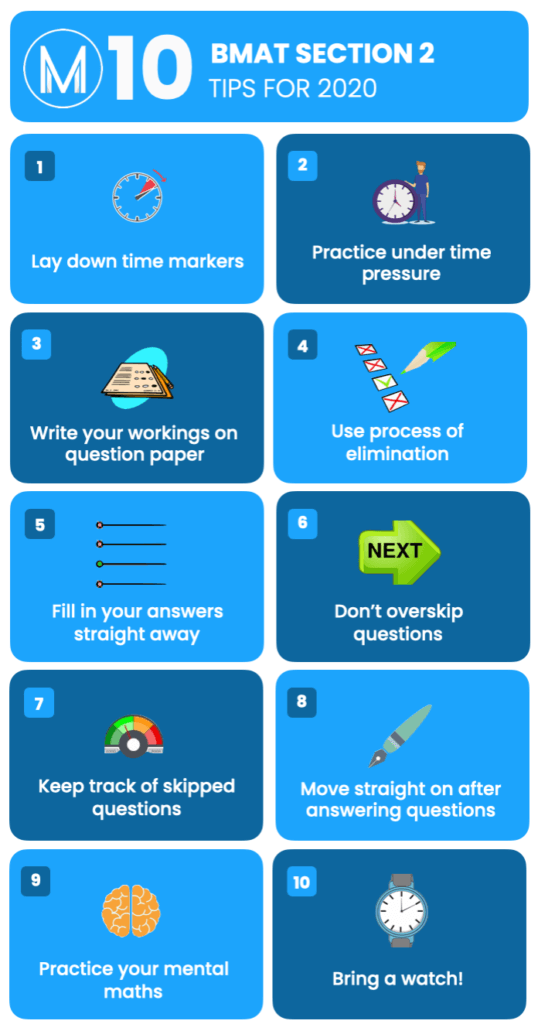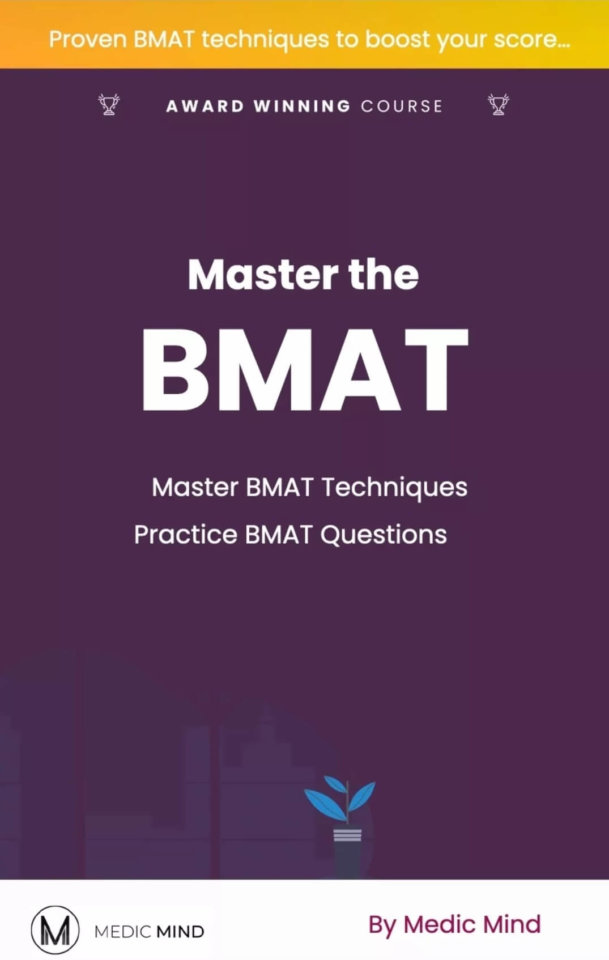Loading...

Qualitative preparation for BMAT practice test Section 2
What is BMAT Section 2?
While Section 1 is geared towards assessing more of the generic skills a medical student might have to draw on, BMAT Section 2 puts candidates’ scientific understanding to the test.
Once again, it’s a multiple-choice assessment (with five to eight options per question). It’s only considerably more time-pressurised than the section before it. You’ll have 30 minutes in which to answer 27 questions. There are usually 7 questions on each of Biology, Chemistry and Physics, and 6 on Maths.

What do I need to know for BMAT Section 2?
The questions rely on GCSE-level understanding of each of the subjects, which is good news if you’re one of many applicants who aren’t taking all three sciences at A-Level. Going back in detail through your GCSE (or equivalent) notes should be enough to cover most of the bases.
The only snag is that BMAT Section 2 has its own specification of assumed knowledge. This probably won’t match up perfectly to your GCSE syllabuses. Reading it through to spot the gaps in your teaching is a must. If you’ve continued onto A-Levels, some of them may already have been filled.
The specific topics you need to cover for each section for BMAT Section 2 are covered below:
Biology
- Cells
- Movement across membranes
- Cell division and sex determination
- Inheritance
- DNA
- Gene technologies
- Variation
- Enzymes
- Animal physiology
- Ecosystems
Chemistry
- Atomic structure
- The periodic table
- Chemical reactions and equations
- Quantitative chemistry
- REDOX reactions
- Bonding and structure
- Group chemistry
- Separation techniques
- Acids, bases and salts
- Rates of reactions
- Energetics
- Electrolysis
- Organ chemistry
- Metals
- Kinetic and particle theory
- Chemical tests
- Air and water
Maths
- Units
- Numbers
- Ratios and proportions
- Algebra
- Geometry
- Statistics
- Probability
Physics
- Electricity
- Magnetism
- Mechanics
- Thermal physics
- Matter
- Waves
- Radioactivity
You’re also expected to be comfortable with the following SI prefixes that could come up in any of the topics of BMAT Section 2:
| Prefix name | Value |
| Nano- | 10-9 |
| Micro- | 10-6 |
| Milli- | 10-3 |
| Centi- | 10-2 |
| Deci- | 10-1 |
| Kilo- | 103 |
| Mega- | 106 |
| Giga- | 109 |
How do I prepare for BMAT Section 2?
Over fifteen years’ worth of past papers are available online, not to mention hundreds of specially-prepared practice questions. These will help you get a feel for the style of the questions, the timing of the paper and level of knowledge required. Note that the specification has changed several times in the past, meaning that some questions may no longer be appropriate.
You’ll need to spend time revising all four subjects just as if you were taking your GCSEs again. Most of it ought to come back fairly easily! Year on year, though, Physics proves a particular cause of stress for future medics. Remember that only around a quarter of the questions will be on Physics and that the most efficient use of your time is to concentrate on the topics that come up the most frequently – check out our revision guides to find out what these are!
Finally, brush up on your mental and pen-and-paper maths. Unlike in the UCAT, you won’t have access to a calculator, so don’t bother using one when you take the practice papers. Being able to handle fractions, percentages and sums quickly will pay dividends on exam day.
How is BMAT Section 2 marked?
Just like BMAT Section 1, each question in BMAT Section 2 is worth one mark and there is no negative marking. Your aggregate marks are then converted into a score with 1 being the lowest and 9 being the highest. In our experience, the average BMAT Section 2 score tends to be approximately 5.0 which is roughly 50%. A score of 6.0 or more is brilliant and only 10% of candidates achieve this. Even fewer BMAT candidates tend to get 6.0 (10%) and even fewer get 7.0 Regardless, you can get a few questions wrong and still achieve a perfect 9.0!
What are your top tips for BMAT Section 2?
With 27 questions to be answered in 30 minutes, Section 2 of the BMAT certainly piles on the time pressure. Putting the science to one side, here are ten tips that’ll optimise your exam technique and help you make the most of your revision.

1. Lay down time markers
On average, you’ll have to complete nine questions every ten minutes. Mentally splitting the section into thirds like this is particularly useful because the response sheet is arranged in three equal columns. Make a written note of the time the section starts and make sure you don’t fall behind.
2. Practise under time pressure
Alongside more thorough BMAT revision, trying a few past papers in full under realistic time pressure is an absolute must. It’s the best way to turn our timing tips into habit and avoid the horror of not answering all the questions. Remember: you can always go over the practice papers in more detail after you’ve finished.
3. Write your workings on the question paper
No extra paper is provided for the BMAT, so when practising, you shouldn’t allow yourself any working space beyond the question paper. Get into the habit of writing enough down clearly to continue your train of thought but not so much that you waste time. Full words are a no-no.
4. Use a process of elimination
This one’s multi-choice exam technique 101. Crossing out answers that are definitely wrong helps you find the right one more quickly, while also improving your chances of a correct guess if necessary. Questions that ask you to identify combinations of correct or incorrect statements succumb particularly well to this strategy.
5. Fill in your answers straight away
Once you’ve worked out an answer with reasonable certainty, write it straight into the response sheet. Waiting until the end to do this wastes time since it involves going back through the entire paper. Worse still, you might not get the chance.
6. Don’t over-skip
It’s advisable to skip the odd question you find hard. But be wary of overdoing this: it throws you off your time markers. Also, it can lead you to panic if you suddenly feel as though you can’t tackle any of them. Holding your nerve and concentrating on a question that seems difficult on first inspection will frequently yield the correct answer and boost your confidence.
7. Keep track of skipped questions
Part of the problem with skipping questions is the time wasted finding and refamiliarising yourself with them. Noting down their numbers at the front or back of the exam paper helps you keep track of how many you’ve skipped and find them with ease.
8. Once you’ve answered a question, move straight on
Surprisingly, perhaps, many good candidates waste time on questions they’ve found easy and answered already. When you’re under pressure, it feels comforting to work back through such questions and reassure yourself that you’ve got a handful right with absolute certainty; but you should be focussed on cracking questions you haven’t yet solved.
9. Practice your mental maths
In the longer term, sharpening your pen-and-paper and mental maths is a great way to improve your Section 2 scores. Without access to a calculator, you’ll have to work comfortably the old-fashioned way with sums, powers, fractions, percentages and decimals – and there’s nothing better than BMAT past papers for developing such skills.
10. Bring a watch!
It sounds silly, but don’t expect yourself to be within clear eyeshot of a clock on exam day. Sticking to your time markers and knowing when to fill in the blanks with clever guesswork is likely to be pretty hard if you’ve got no idea how much time you have left.

Frequently Asked Question
→What is the BMAT practice test Section 2?
The BMAT (BioMedical Admissions Test) practice test Section 2 is an assessment designed to test a student’s ability to comprehend and analyse a given passage, usually related to scientific or medical topics.
→What is qualitative preparation for BMAT practice test Section 2?
Qualitative preparation for BMAT practice test Section 2 involves developing the skills required to read, comprehend and analyse scientific passages in a limited amount of time. This includes developing the ability to understand scientific terminology, identify key information, and draw conclusions.
→What is a good score for BMAT section 2?
A good score for BMAT Section 2 varies depending on the specific requirements of the university or program to which a student is applying. Generally, a score in the range of 5.0 to 7.0 is considered a competitive score for most universities, although some may require a higher score. It is important to research the specific requirements of the programs to which you are applying and aim to achieve a score that meets or exceeds their expectations. It is also important to note that BMAT scores are just one aspect of the admissions process, and other factors such as academic achievement, extracurricular activities, and personal statements may also be considered.
→What resources are available for qualitative preparation for BMAT practice test Section 2?
There are many resources available for qualitative preparation for BMAT practice test Section 2, including study guides, practice tests, online courses, and tutoring services. Students can also find helpful information and tips on various websites and forums dedicated to BMAT preparation.
→How important is qualitative preparation for BMAT practice test Section 2?
Qualitative preparation is critical for the BMAT practice test Section 2, as it requires a high level of comprehension and analytical skills to succeed. With proper preparation, students can increase their chances of performing well on the test and gaining admission to their desired medical or scientific programs.
Related Articles
With over 1000 BMAT questions, mock paper walkthroughs, tips & advice, and more!
Get support with the BMAT essay through personalised support and advice
Personalised private lessons, tailored to your BMAT needs





Was this article helpful?
Still got a question? Leave a comment
Leave a comment